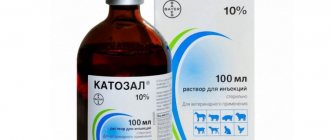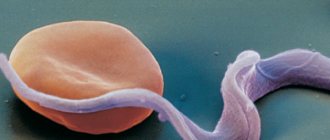Low temperature in dogs and cats
Constant body temperature is one of the defining characteristics of a living warm-blooded organism.
The normal body temperature of dogs and cats is 38-39 C. The center of thermoregulation is the medulla oblongata. There are several mechanisms that ensure constant body temperature. These include sweating, intense breathing with an open mouth, and trembling. A feature of the structure of the skin of dogs and cats is the absence of sweat glands on a large surface of the body. They are present only in the skin of the nose and paw pads. Therefore, to cool the body, an additional mechanism is needed, which is open-mouth breathing. A large amount of hot water vapor evaporates from the mucous membranes of the oral cavity, which helps cool the entire body. Shivering, being essentially a muscle contraction, is designed to increase body temperature. An increase in body temperature (hyperthermia) is often not only a protective mechanism of the body - a reaction to the introduction of foreign agents (viruses, bacteria, protozoa), but also a sign of an inflammatory process.
A decrease in body temperature in cats and dogs (hypothermia) below the physiological norm is a threatening sign that should alert owners. Often the temperature decreases in weakened kittens and puppies due to viral diseases in which immunosuppression occurs. Reduced body temperature in cats and dogs in old age can be observed with chronic kidney and/or liver diseases and may not manifest itself symptomatically. The physiological norm is a decrease in temperature in females during the prenatal period (about a day before birth, the temperature decreases by 1 degree). When animals are kept in cold rooms or outdoors at subzero air temperatures, a decrease in body temperature also occurs. The temperature decreases with polytrauma, bleeding, and also during anesthesia.
The processes occurring in the body during hypothermia are associated with a decrease in metabolic rate. Low temperature in dogs and cats is accompanied by symptoms such as weakness, bradycardia (slow heart rate), rare shallow breathing, hypotension (low blood pressure), slowed intestinal motility, and decreased diuresis. In general, we can talk about a state of shock in the body.
Treatment consists of gradually warming the animal using heating pads, intravenous infusion with warm solutions, and relieving the symptoms of the underlying disease. Constant monitoring of body temperature by thermometry is necessary (it is better to use an electronic thermometer with a flexible tip, which is inserted into the anus to the length of the metal tip) and oxygen therapy until the condition stabilizes. The main treatment is aimed at eliminating the causes of hypothermia.
Preventive measures for hypothermia in newborns and young animals include maintaining the temperature in the premises and preventing viral infections. For adult animals, a reasonable approach to regulating festivities is necessary (especially at sub-zero air temperatures); for dwarf and smooth-haired breeds, it is advisable to use special clothing.
© Katane Anastasia Vladimirovna, Veterinary therapist Moscow city veterinary care Call a doctor to your home.
The processes occurring in the body during hypothermia are associated with a decrease in metabolic rate. Low temperature in dogs and cats is accompanied by symptoms such as weakness, bradycardia (slow heart rate), rare shallow breathing, hypotension (low blood pressure), slowed intestinal motility, and decreased diuresis. In general, we can talk about a state of shock in the body.
Actions in case of deviation from the norm
An attentive owner will always understand that something wrong is happening to the cat: external signs that differ in hyper- and hypothermia will tell him about it.
At reduced temperatures the following are noted:
- bradycardia;
- decreased activity and lethargy;
- hypotension;
- blanching of mucous membranes;
- slow breathing, sharp inhalation/exhalation.
- trying to find a warm place.
At elevated temperatures the following are observed:
- tachycardia;
- chills and fever;
- loss of appetite and refusal to drink water;
- drowsiness and apathy;
- dehydration (with prolonged fever);
- diarrhea and/or vomiting with a bad smell (in severe cases).
In general, you should be wary of any deviations from the temperature norm, as they can signal various diseases, sometimes very serious ones.
If the elevated temperature
An increase in temperature can be caused by both diseases and other (non-physiological factors):
- viral diseases - cats usually have distemper (panleukopenia), calicivirus, rhinotracheitis and coronavirus;
- inflammatory processes - often occur when wounds or postoperative sutures become infected;
- overheating - kittens, old and weakened cats that are forced to stay in the heat for a long time, for example, in a car or in a stuffy room, often suffer from it;
- stress often provokes a failure of thermoregulation. The reasons may be a trip in transport, a visit to the veterinarian, a change of owner or place of residence.
This is interesting! The temperature often rises by about 1 degree after vaccination, when the body produces antibodies against viruses, or sterilization (as a reaction to surgery).
Actions at elevated temperatures
If going to the vet is not possible, use the following methods to reduce the fever:
- humidify the air in the room;
- give the cat cool water (if it refuses, drink it from a syringe without a needle or pipette);
- moisten exposed skin with water;
- wrap in a wet towel;
- Place ice behind your ears, neck, or inner thighs.
Self-treatment, especially with the use of drugs developed for the human body, is not allowed. Antibiotics and antipyretics can negatively affect the cat’s body, causing allergies or liver/kidney problems.
If the low temperature
The reasons for a drop in temperature in a cat are internal pathologies and external factors, such as:
- exhaustion and loss of strength caused by chronic malnutrition;
- viral infections (against the background of weakened immunity);
- dysfunction of internal organs (heart and blood vessels, endocrine system, liver and kidneys);
- blood loss that occurs after injuries and operations (internal bleeding is especially dangerous, which the owners do not notice immediately):
- helminthiasis – infection with parasites leads to exhaustion, anemia and impaired thermoregulation.
But the most common cause of a drop in temperature is hypothermia, which occurs after a cat has been in the cold for a long time.
Actions at low temperatures
If hypothermia is caused by hypothermia, your pet needs to be warmed up quickly:
- wrap in a blanket/plaid;
- place in a warm, wind-free place;
- give warm liquid to drink (you can use a pipette);
- Cover with heating pads or hot water bottles.
If your efforts are ineffective, take the cat to the hospital. There, most likely, she will be given a warm enema and put on a drip with saline solution.
We recommend reading: The Cat Is Trying Cannot Give Birth
Normal body temperature and pulse in dogs and cats
In this short article we want to talk about what body temperature and pulse indicators are normal in dogs and cats. This information will be useful to all pet owners, as it is important for assessing the condition of the animal.
| Dogs | o C |
| Puppies | 37,5-39 |
| Adult dog | 37,5-39 |
| Cats | |
| Kittens | 38,5-39,5 |
| Adult cat | 38,0-39,5 |
It is worth paying attention to the fact that in small breeds of dogs the body temperature may be higher and ranges from 38.0-39.5, which is not a sign that your dog is sick.
Depending on environmental conditions and the time of year, these indicators may vary. So, in the hot season, with long walks in the sun, the dog’s body temperature can rise by up to 40 degrees or more, which becomes dangerous to health. When animals are kept crowded in stuffy rooms, an increase in body temperature can also be noted. During physical activity, body temperature may also increase slightly, but after some time it returns to its physiological values.
To measure your pet's body temperature, you will need a thermometer. It is better to use an electronic one, since the time spent on the procedure is much less than when using a conventional mercury thermometer.
The tip of the thermometer should be lubricated with some ointment, for example, baby cream or levomekol, carefully insert the thermometer 1.5-2 cm into the anus and in the case of an electronic thermometer, wait until the sound signal or about 1 minute, and in the case of a mercury thermometer - about 5 minutes.
Heart rate (pulse).
The normal heart rate in dogs and cats is:
| Dogs | beats/min |
| Small dogs | 100-130 |
| Large dogs | 70-100 |
| Cats | |
| Kittens | 130-140 |
| Adult cat | 100-120 |
During physical activity, stress, and illness, the heart rate increases.
The normal heart rate in dogs and cats is:
How to bring down or increase the temperature
If a cat's body temperature increases or decreases, in order to temporarily alleviate its physiological condition, it is possible, depending on the situation, to lower or increase the temperature.
Attention! There is no treatment for temperature as such; temperature is only a symptom indicating the presence of pathology in the animal’s body.
In order to bring down the temperature, you need to wrap the cat in a damp, cold towel, give it a cold drink (slightly below room temperature), put it in a cool place without drafts, but under no circumstances on a concrete floor or ground. If the temperature rises due to illness, it is necessary to urgently begin treatment for the disease and take a course of IV drips to reduce the temperature.
A pet with hyperthermia should never be given fever-reducing medications intended for humans.
First aid for fever is to wrap the animal in a cold, wet towel and take it to the clinic. Drinking water must be available at all times.
To increase the temperature, the cat must be placed on a warm heating pad, and bottles of warm water wrapped in a rag should be placed next to it (to prevent burns). Give a warm drink. If a decrease in temperature occurs against the background of a disease, immediately begin treatment and raise the temperature in a veterinary clinic.
First aid for a low temperature is to put the cat on a heating pad, give him warm water to drink and take him to the clinic.
Normal temperature in cats is higher than in humans
Temperature is an indicator of health status
Our pet cannot complain and say in human language what and where it hurts. Therefore, you need to determine the health status of your four-legged friend yourself. An important indicator of this is temperature. There are common myths about how to measure it in animals. It is believed that to find out what the temperature of cats or dogs is, it is enough to touch their nose.
How to measure body temperature in cats
Just like in dogs - rectally. Naturally, it is best to use an electronic thermometer, which can measure the temperature in 10 seconds. It is easy to use and there is no risk of it breaking. If you do not have an electronic thermometer, then you can use a regular mercury thermometer, but then someone needs to hold the cat, fixing it in one position for about five minutes. Because it’s hard to explain to a kitty why you need to stand still all this time with a thermometer in the anus. Let's say the entire procedure for inserting the thermometer was successful. You look at the scale and you are overcome with horror: 38 degrees! Horror, the animal has a fever! Do not rush to the veterinary hospital, because the normal temperature in cats is significantly higher than that in humans. Why? It's all about the banal level of metabolism.
What is the normal temperature for cats?
The smaller the size of a warm-blooded creature, the faster life processes occur in its body: the heart beats faster, metabolism increases and body temperature increases. Therefore, a mouse has a higher internal body temperature than a human, while an elephant has a lower one. In addition, the same animal can have different indicators of body heat, while remaining absolutely healthy. Even people usually have 36.1 degrees in the morning, and as the day progresses the temperature gradually rises, reaching 37.2 in the evening. And these indicators do not at all indicate any pathology. The same thing is observed in cats. If an animal is resting or moving little, then its body is colder than when it is playing or running. Normal temperature in cats varies between 37.8 – 38.9 degrees Celsius. In kittens these figures are slightly higher: 39-39.5 C.
Does a cat's breed affect its body temperature?
No, being a hairless breed does not make your pet any special in this regard. The normal temperature in cats (38-39.5 C) applies to all representatives of this biological species, no matter whether it is a Sphynx or a British Blue. Short-haired animals appear warmer than their furry counterparts because there is no hair between your hand and their skin to “lower” the temperature.
What to do if your pet has a fever?
The normal temperature in cats changes dramatically in the event of a bacterial infection. This is how the body reacts to a viral attack. There are a number of diseases when the temperature does not rise, but rather drops sharply. Both of these cases are dangerous to the health and life of the animal. Never give your cat antipyretics intended for humans - this will only harm your pet. Contact your veterinarian, especially if you see that changes have affected not only body temperature, but the entire behavior of your pet. If he is lethargic, moves little, breathes quickly, does not eat, and his eyes are partially closed by the third eyelid, there is cause for serious concern. Temperatures below 37° and above 40.5° require urgent contact with a specialist.
What to do if your pet has a fever?
What is the normal body temperature for humans, dogs, cats and other animals?
| 09.10.2020 09:07 |
| The general health of any living creature depends on the value of body temperature and pulse rate. So what is the normal temperature for humans, dogs, cats and other birds and animals? So, what is the normal body temperature and pulse rate for various animals and birds? Body temperature, degrees Celsius Pulse rate, number of beats per minute
|











